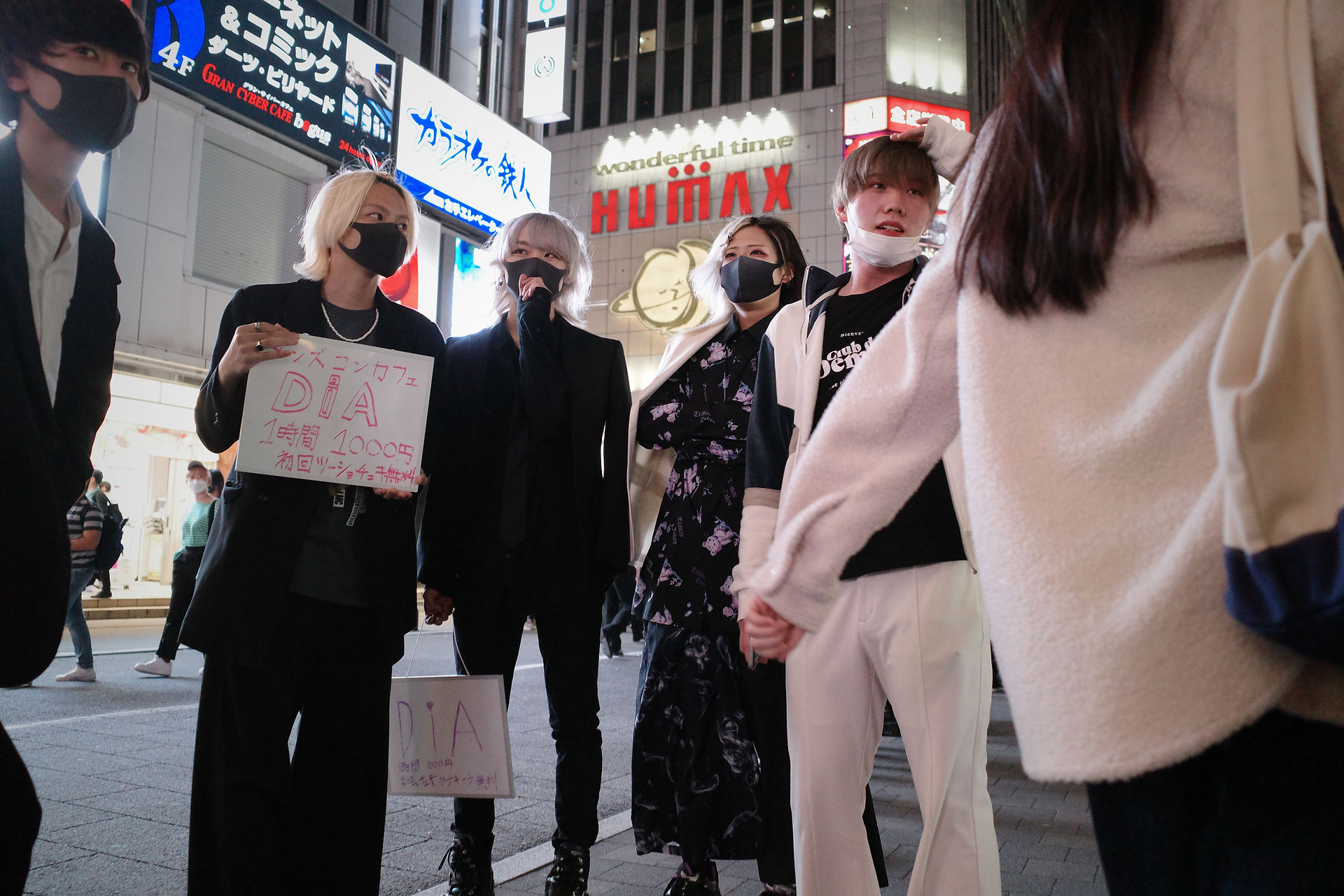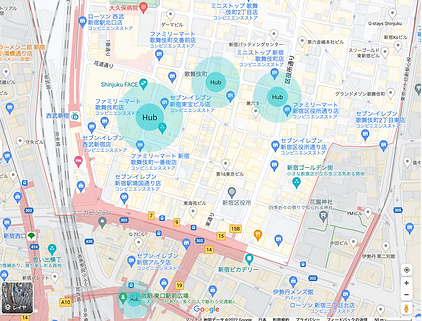
The Utilization of Space
Reasons of Having Hubs
by Nanami
As well as the scouts' steps, what they create in spaces is pretty rationalized. Scouts’ hubs exist for them to station with other collective scouts. With a centrally located hub, scouts work to approach targets. The location of hubs are purposefully determined to be a preferred place for scouts. Aside from territories, hubs have unique features with a solid purpose. They live up to scouts’ ideal conditions which are accessibilities of targets, connections with other scouts, and leveraging undercover identities.

The hub on Moa 2nd street
Accessible Places to Find and Approach Targets
Hubs are located in which allows scouts to easily scan pedestrians coming from several directions. Hence, the access to find and approach targets is easy for scouts although securities are intensified there.
Having examples of hubs in the order of biggest sizes of hubs, Moa 2nd street, Shinjuku east exit Hiroba, Hanamichi-dori are the major hubs in Kabuki-cho.


Sizes and locations of hubs in Kabuki-cho
Communication with Peers
Scouts communicate in their hubs with an eye on pedestrians. As the picture on the left shows, there is a man in a suit, which is different from common scouts. Scouts communicate with the man in a suit as well while the man never approaches targets but talks with scouts and takes a look at his phone the whole time. Considering their attitudes, they should be business associates. The man may be the owner of hostess clubs. The hub plays an important role in exchanging information with other scouts and communicating with the owner of hostess clubs.

1
Moa 2nd street (the picture above) has two lanes in which pedestrians go different directions. This location allows scouts to see pedestrians coming from both Shinjuku station and Kabuki-cho. Types of people are different depending on where they come from so that scouts can expand the range of pedestrians who they recognize as targets. Although Moa 2nd street has a lot of surveillance: monitoring cameras, announcements, and security guards, scouts can still survive through reinforced surveillance because the advantageous conditions in that location outweighs risks.
A hub on Moa 2nd street
2
For Hanamichi-dori, it has many adult-entertainment shops nearby such as host/hostess clubs. The hub is located at the cross of Hanamichi-dori and other streets. Therefore, scouts can scan pedestrians coming from different directions such as Sakura-dori and Central road. The hub on Hanamichi-dori is built around night time, 9 to 12 p.m., because scouts know the types of pedestrians who can be a target on that time of day are limited. Considering the fact of both location and time of the hub, the accessibility of the hub to targets is marvelously calculated. On Hanamichi-dori, there is almost no surveillance other than pedestrians’ eyes, which is the best condition for scouts to achieve their goal.

The hub on Hanamachi-dori

3
For Hiroba, it has heterogeneous pedestrians heading to Kabuki-cho, heading back from Kabuki-cho, or hanging around the station. At first, it seems difficult to narrow down targets for scouts; however, targets are not pedestrians there but people waiting in front of the east exit. There are tons of people waiting for friends in that place around 5 to 7 pm, in other words, they never hunt in the night time because there are barely people waiting for friends around there. Scanning people just standing there is a spatially adaptable strategy.
Standing people who can possibly be a target in front of Shinjuku East Exit
Undercover Identities
When scouts are in their hubs, they mimic pedestrians. Just standing in the middle of the street with other men, there is no doubt to presume they are one of the pedestrians. Their undercover identities can illude both security and pedestrians' eyes by not standing out. Pretending to be a pedestrian, targets never see them as suspicious persons. This can be applied to what Simmel says as "blase attitude".
Simmel (1900) mentions “The essence of the blasé attitude is an indifference toward the distinctions between things. Not in the sense that they are not perceived, as is the case of mental dullness, but rather that the meaning and the value of the distinctions between things, and therewith of the things themselves, are experienced as meaningless. They appear to the blase person in a homogeneous, flat and grey color with no one of them worthy of being preferred to another (p.14)".
As he suggests, once pedestrians have blasé attitudes toward scouts in a hub, they never distinguish scouts and other pedestrians on purpose because they are indifferent toward the scouts there (Wirth, 1938).

How blasé attitude applies to scouts in a hub
As scouts in a hub were objects, pedestrians would ward off the group of scouts in the hub. They simply adjust placed situations which make urbanites respond to as it is there.
Simmel (1900) describes that "the metropolitan type which naturally takes on a thousand individual modifications creates a protective organ for itself against the profound disruption with which the fluctuations and discontinuities of the external milieu threaten it. Instead of reacting emotionally, the metropolitan type reacts primarily in a rational manner, thus creating a mental predominance through the intensification of consciousness, which in turn is caused by it (p. 12)".
Conclusion
This is important for scouts to evade surveillance because the security under locations of hubs are especially reinforced. Hubs are located in which scouts can exchange information and enlarge the types of people scouts face without any danger.
INTRODUCTORY PAGE
Sections
the utilization of space
ANALYSIS PAGE
